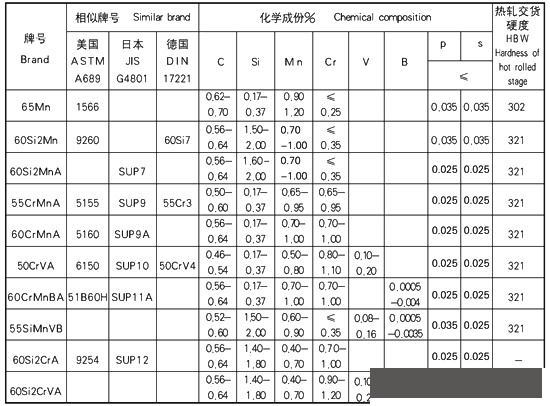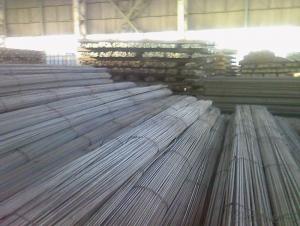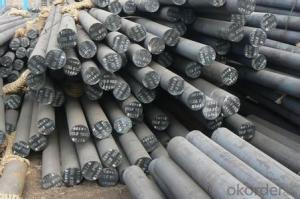Spring Steel 65Si2Mn
- Loading Port:
- China Main Port
- Payment Terms:
- TT OR LC
- Min Order Qty:
- -
- Supply Capability:
- -
OKorder Service Pledge
Quality Product, Order Online Tracking, Timely Delivery
OKorder Financial Service
Credit Rating, Credit Services, Credit Purchasing
You Might Also Like

Minimum order Quantity:100tons
Sizes:50--200mm
Application: The spring steel can be used to make the spring which is used in the car, truck,vessel etc.
- Q:What are the advantages of using nickel-chromium-aluminum alloy steel round bars?
- There are several advantages of using nickel-chromium-aluminum alloy steel round bars. Firstly, this alloy steel offers excellent corrosion resistance, making it ideal for applications in harsh environments or industries where corrosion is a concern. This resistance to corrosion helps extend the lifespan of the round bars, reducing maintenance and replacement costs. Secondly, nickel-chromium-aluminum alloy steel round bars have high strength and durability. This makes them suitable for applications that require heavy loads or need to withstand high temperatures. Their strength also allows for increased structural stability, making them a reliable choice for various construction projects or industrial applications. Additionally, this alloy steel has excellent thermal stability, meaning it can maintain its shape and mechanical properties even at elevated temperatures. This makes it particularly useful in industries such as aerospace, automotive, and power generation, where high temperatures are common. Moreover, nickel-chromium-aluminum alloy steel round bars exhibit good formability and machinability, allowing for easy fabrication and customization. This makes them versatile and adaptable for various manufacturing processes, enabling the production of complex shapes and designs. Lastly, this alloy steel is known for its resistance to oxidation and scaling at high temperatures. This characteristic makes it suitable for applications that involve exposure to extreme heat or rapid temperature changes, such as in furnaces or heat exchangers. In summary, the advantages of using nickel-chromium-aluminum alloy steel round bars include excellent corrosion resistance, high strength and durability, thermal stability, formability, and resistance to oxidation. These qualities make it a preferred choice for a wide range of industries, ensuring reliable performance and longevity in various applications.
- Q:Can steel round bars be used for making suspension springs?
- Yes, steel round bars can be used for making suspension springs. Steel is a common material choice for suspension springs due to its strength, durability, and ability to withstand high loads and vibrations. Steel round bars can be readily shaped, tempered, and heat-treated to meet the specific requirements of suspension springs, providing necessary flexibility and resilience.
- Q:Can steel round bars be used for construction purposes?
- Indeed, construction purposes can make use of steel round bars. Several applications in construction commonly utilize steel round bars, including reinforcement in concrete structures, support for beams and columns, and as structural components in bridges, buildings, and infrastructure projects. The exceptional tensile strength and durability of steel render it a perfect option for construction purposes, capable of withstanding heavy loads, providing stability, and ensuring the longevity and safety of structures. Furthermore, steel round bars offer versatility, as they can be easily fabricated and customized to meet specific project requirements. Hence, due to their excellent mechanical properties, reliability, and cost-effectiveness, steel round bars find extensive use in the construction industry.
- Q:What is the maximum phosphorus content allowed for steel round bars?
- The maximum phosphorus content allowed for steel round bars typically ranges from 0.04% to 0.10%.
- Q:How are steel round bars used in the manufacturing of hydraulic systems?
- Steel round bars are commonly used in the manufacturing of hydraulic systems as they provide strength, durability, and stability to various components such as pistons, cylinders, and shafts. They are machined and shaped to create precision parts that can withstand high pressure and repetitive movements. The use of steel round bars ensures the reliable and efficient functioning of hydraulic systems, making them an integral part of their construction.
- Q:Is steel bar round wire? What's the difference? What are the main applications of wire rod?
- The difference between steel and other steel: 1 is not the same, round shape light garden, no pattern without ribs, other steel surface appearance is engraved or ribbed. Bond thus causing steel and concrete, and the bond strength of steel and concrete. The other 2 ingredients are not the same, (a steel bar) belongs to the ordinary low carbon steel, alloy steel reinforced many other. 3 strength is not the same. The low strength steel and other steel with high strength, i.e., diameter of the same size as compared with other steel, round steel can bear the pulling force than other reinforced small, but the plastic steel reinforced bar is stronger than the other, larger the deformation in the break before, while the other bars in the break before the deformation is much smaller.
- Q:Are steel round bars suitable for use in the manufacturing of springs?
- Indeed, steel round bars prove to be a fitting choice when it comes to the fabrication of springs. The widespread use of steel round bars in spring production is owed to their exceptional sturdiness and longevity. The bar's circular form facilitates effortless bending and molding into diverse spring patterns. Moreover, steel boasts exceptional elasticity, rendering it an optimal material for springs that must absorb and retain mechanical energy. Furthermore, steel round bars exhibit commendable resistance to corrosion, an essential attribute for springs subjected to environmental elements. On the whole, steel round bars possess the essential qualities requisite for the creation of superior and dependable springs.
- Q:What are the options for joining steel round bars?
- Joining steel round bars can be achieved through various methods, depending on specific requirements and applications. Some commonly used techniques include welding, bolting, adhesives, mechanical couplings, and cold forming. 1. Welding is a widely employed method to join steel round bars. It entails melting the ends of the bars and fusing them together using arc welding, MIG welding, or TIG welding. This technique ensures a robust and durable joint capable of withstanding high loads and stresses. 2. Bolting involves using bolts, nuts, and washers to connect steel round bars. Holes are drilled through the bars, and bolts are inserted, securing them together by tightening the nuts. Bolting is a relatively simple and swift method that allows for disassembly and reassembly, if necessary. 3. Adhesives can also be utilized for joining steel round bars. Industrial-strength adhesives are applied to the mating surfaces of the bars, which are then pressed together and left to cure. This bonding technique can provide a sturdy and durable joint, particularly when welding or bolting may not be feasible or desired. 4. Mechanical couplings, specifically designed for joining steel round bars, are comprised of two separate components fitted over the ends of the bars. These components are tightened together using screws, clamps, or other mechanical means, ensuring a reliable and secure joint without the need for welding or drilling. 5. Cold forming techniques, such as swaging or crimping, can also be employed to join steel round bars in certain cases. These methods involve mechanically deforming the ends of the bars to create a tight and secure joint. Cold forming is often utilized in applications where welding or other traditional methods are unsuitable. When selecting the appropriate method for joining steel round bars, it is crucial to consider specific requirements, load-bearing capacities, and environmental conditions. Consulting with a professional engineer or welder can help determine the best option based on the specific application and desired outcome.
- Q:What are the advantages of using precipitation-strengthened steel round bars?
- Using precipitation-strengthened steel round bars in various applications offers several benefits. Firstly, these bars possess improved mechanical properties, making them stronger and more durable compared to regular steel bars. Through the heat treatment process of precipitation hardening, fine particles form within the steel structure. These particles act as obstacles to dislocation movement, resulting in enhanced strength and hardness. Secondly, the increased strength of precipitation-strengthened steel round bars allows for material usage reduction while maintaining the desired level of structural integrity. This leads to cost savings in terms of raw materials and transportation, making it an economical choice in the construction and manufacturing industries. Additionally, precipitation-strengthened steel round bars exhibit excellent corrosion resistance properties. The formation of fine particles during precipitation hardening creates a dense and uniform microstructure, effectively blocking the movement of corrosive agents. This corrosion resistance makes these bars ideal for applications in harsh environments or industries where exposure to corrosive substances is common. Another advantage of using precipitation-strengthened steel round bars is their ability to withstand high temperatures. The fine particles within the steel structure contribute to improved thermal stability, enabling these bars to maintain their strength and hardness even under elevated temperatures. This makes them suitable for applications involving high-temperature operations, such as in the aerospace and automotive industries. Furthermore, precipitation-strengthened steel round bars possess superior fatigue resistance, making them advantageous in applications that require repetitive or cyclic loading. The precipitation hardening process enhances the material's resistance to fatigue failure, allowing it to withstand prolonged stress without significant deformation or failure. This makes these bars suitable for use in structures subjected to dynamic or fluctuating loads, such as bridges, cranes, and machinery components. In conclusion, precipitation-strengthened steel round bars offer enhanced mechanical properties, reduced material usage, excellent corrosion resistance, high-temperature stability, and superior fatigue resistance. These advantages make them the preferred choice for a wide range of applications, spanning from construction and manufacturing to the aerospace and automotive industries.
- Q:How to distinguish a round bar from forging? Cold drawing? Hot rolling?
- Round bar is divided into three parts: hot rolling, forging and cold drawing. Standard Specification for hot rolled round steel is 5.5-250 mm. Where: 5.5-25 mm small round steel mostly straight bundles of supply, used for steel, bolts and various mechanical parts; greater than 25 mm round steel, seamless steel pipe is mainly used for the manufacture of mechanical parts of the tube, etc..
1. Manufacturer Overview |
|
|---|---|
| Location | |
| Year Established | |
| Annual Output Value | |
| Main Markets | |
| Company Certifications | |
2. Manufacturer Certificates |
|
|---|---|
| a) Certification Name | |
| Range | |
| Reference | |
| Validity Period | |
3. Manufacturer Capability |
|
|---|---|
| a)Trade Capacity | |
| Nearest Port | |
| Export Percentage | |
| No.of Employees in Trade Department | |
| Language Spoken: | |
| b)Factory Information | |
| Factory Size: | |
| No. of Production Lines | |
| Contract Manufacturing | |
| Product Price Range | |
Send your message to us
Spring Steel 65Si2Mn
- Loading Port:
- China Main Port
- Payment Terms:
- TT OR LC
- Min Order Qty:
- -
- Supply Capability:
- -
OKorder Service Pledge
Quality Product, Order Online Tracking, Timely Delivery
OKorder Financial Service
Credit Rating, Credit Services, Credit Purchasing
Similar products
New products
Hot products
Hot Searches
Related keywords































